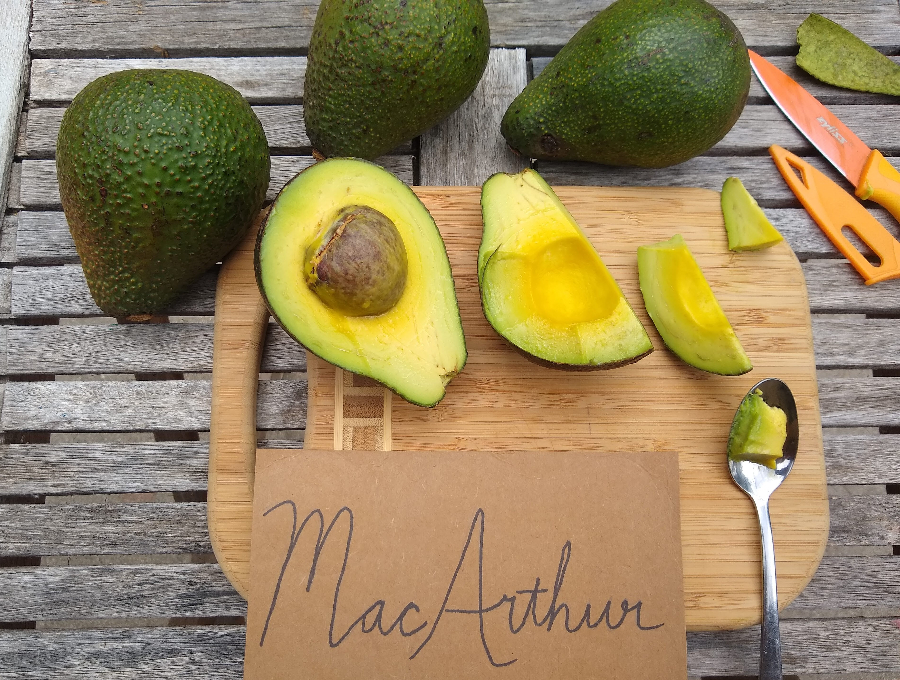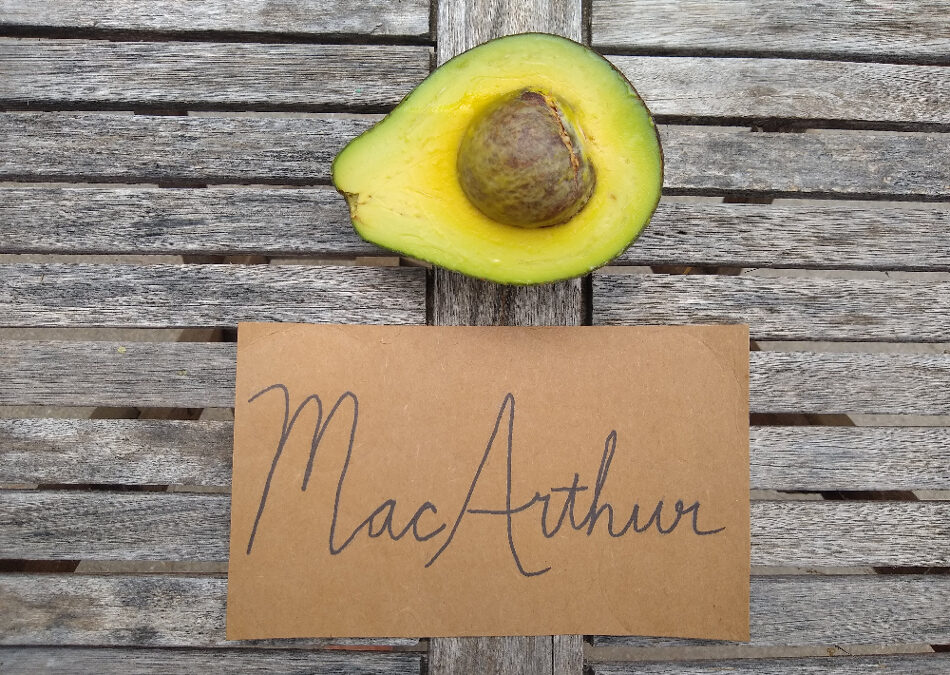Thomas Shedden’s mother lived to age 95. Avocados formed a large part of her diet, and it was Shedden’s belief that his mother’s longevity and good health was due to this. In her honor, Shedden named an avocado that he discovered after her, MacArthur being his mother’s maiden name.
The original MacArthur avocado tree grew about 1922 on Shedden’s property in Monrovia, at the foothills of the San Gabriel Mountains of Southern California. There Shedden maintained a large collection of avocado varieties “in order that he might make comparative studies of their value and distribute budwood of the most promising.”
By 1950, MacArthur was a variety recommended for commercial planting by the California Avocado Society, of which Shedden had been a charter member. And in 1960, MacArthur avocados were the third most popular variety marketed by Calavo Growers, the largest seller of avocados, only behind the Fuerte and Hass varieties.
MacArthur avocado
The MacArthur avocado’s skin remains green when ripe, and the fruit has the shape of a Bartlett pear. Its size is larger than Hass.
Cut open, its flesh shows only a few dark fibers at the stem end and its seed is medium in size, usually round but sometimes having a small point at its top.

The skin is medium in thickness, similar to Hass, and it peels off the flesh cleanly.
In texture, MacArthur avocados lean toward wet and soft, similar to Sir-Prize, convenient for mashing on a slice of sandwich bread or toast. The oil content is moderate.

MacArthur’s flavor is pleasant, not strong, sometimes subtly sweet. And I sometimes sense a background flavor that I experience in a few other avocado varieties (Hellen, for example), which I don’t have words to describe except to say that it’s a kind of bitterness.
The harvest season for MacArthur is summer.
Where did MacArthur go?
Today, you might find MacArthur avocados appearing in a few farmers market stalls in the Ventura and Santa Barbara areas but that’s it. The variety was recommended for commercial planting in those areas only, and farmers market fruit come from old leftover trees there.
I know of a few old MacArthur trees in backyards in Los Angeles County, but I never see young MacArthur trees sold in nurseries these days.
As a summer variety, MacArthur is good but not the best. Inheriting a yard with a mature MacArthur tree would be a blessing; however, if I were choosing a summer variety to plant, I would prefer Reed.
Thomas Shedden once wrote, “I hope to live long enough to see the avocado an acceptable, plentiful, reasonably priced, daily food of the rich and the poor alike.”
He died in 1935, too soon to experience what he hoped for, but Shedden’s efforts at testing, discovering, and sharing avocados during those early years when few Americans outside of California and Florida had even heard of an avocado helped it come true for us today.
(See this obituary for Shedden in the 1936 California Avocado Society Yearbook.)
Video profile
Enjoy my video profile of Thomas Shedden’s MacArthur avocado:
You may have noticed that there are no ads on this website. That’s because I rely exclusively on your direct support to keep them up and coming. Thanks for all the support.
All of my Yard Posts are listed here.
All of my avocado variety profiles are listed here.




Such an interesting history for all these varieties. Assuming no MacArthur’s coming our way…but yes to some REEDs later this summer? It is host it seemed like the Gwen batch didn’t fare quite as well as during the cooler months on the counter. They turned black sooner than I expected. Just finished the last couple. Still tasted good!
Hi Mariangela,
I’m working on getting some Reeds in a couple weeks. I don’t have enough Reeds here to sell this year so I’m asking friends if they do.
That last batch of Gwens was a tough one! I’ve learned some lessons. I will no longer harvest and ship in such heat, as it is hard on me and hard on the avocados. I will also “snap pick” Gwens from now on. I found that many of them with clipped stems got some stem end rot, but those whose stems I snapped completely off did not. This is a phenomenon that others have also noticed with late-season Hass.
I’m sorry if any of the Gwens weren’t perfect. I will gladly send a replacement box. (But not during a heat wave!)
Thank you, Greg, for your thoughtful and balanced reviews of so many interesting avo varieties! I always enjoy them and find myself wanting to try growing what I tell my wife will be “just one more” variety!
We recognize your reviews are focused on cultivars which are grown in California – especially SoCal – and we appreciate that this is where you live and understandably focus your comments on. However, we live in NE Florida (Zone 9b) and would welcome even speculative comments you might be willing to make about cultivating avos in our area too. We have a lot of marshy ground here and recognize the need to get our avo roots up and out of the wetness, but our bigger challenges are extremely humid and hot summers with lots of afternoon wind and thunder storms between July and September. We can manage risks from sun, winter lows which can be in the 20s, and wind, but would especially welcome any speculation/comments you might be willing to offer about which cold-tolerant varieties might be more humidity-resistant than others.
Thanks again for your terrific work.
Gavin Murray
St. Johns, Florida
Hi Gavin,
Thanks for this nice comment. I do try to be very careful not to talk about anything I don’t have sufficient firsthand experience with, and that certainly includes growing avocados in your conditions. That said, I know where I would turn for good info on the performance of varieties where summers are hot and humid. I would look at what Carlos down in south Florida (Homestead) has to say, and I would read anything written by the South Africans.
Here is Carlos’s website: https://www.myavocadotrees.com/
Here are the yearbooks of the South African Avocado Growers Association: http://www.avocadosource.com/Journals/SAAGA/SAAGA_TOC.htm